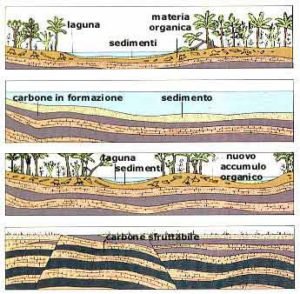The formation of coal
 Coal is a combustible black or dark brown sedimentary rock consisting of amorphous carbon, hydrocarbons and, in smaller amounts, sulphides and other secondary components. Coal is the result of the very slow decomposition (pyrolysis) of biomass – mostly vegetables – buried under sediment layers of varying thicknesses. In order for coal to form, organic remains must rapidly find themselves under anoxic conditions immediately after their death or disarticulation. Ideal environments for these processes are the places that facilitate the rapid burial of uprooted plants, such as river mouths, or those where oxygenation rates are quite low, such as lakes, swamps and peat bogs.
Coal is a combustible black or dark brown sedimentary rock consisting of amorphous carbon, hydrocarbons and, in smaller amounts, sulphides and other secondary components. Coal is the result of the very slow decomposition (pyrolysis) of biomass – mostly vegetables – buried under sediment layers of varying thicknesses. In order for coal to form, organic remains must rapidly find themselves under anoxic conditions immediately after their death or disarticulation. Ideal environments for these processes are the places that facilitate the rapid burial of uprooted plants, such as river mouths, or those where oxygenation rates are quite low, such as lakes, swamps and peat bogs.
Under these conditions, the plant remains buried under sediments – in particular the organic part making up the wood (oxygen, hydrogen, nitrogen) – are attacked and progressively decomposed by anaerobic bacteria which metabolize them and enrich their main inorganic component – carbon – determining, depending on the time required for the remaining mass to be compressed, a volume-carbon ratio which generates different types of fuel. Coal can be classified based on chemical, petrographic, geological or rank criteria.
Classification
In the past, the most frequently used classification included four basic types: peat, lignite, litantrace and anthracite. Today, the rank classification, which is based on the US model, is the most widely used; according to this classification, chemical-physical characteristics define the degree of maturity of coal, and the related geological age of formation is not taken into account.
This classification incudes – with progressive qualitative characteristics – lignite, sub-bituminous, bituminous and anthracite coal.
The “Carbone Sulcis”, found in the Serbariu coal basin and defined in the past as lignite, is sub-bituminous according to the current classification criteria.
Sardinia mines
